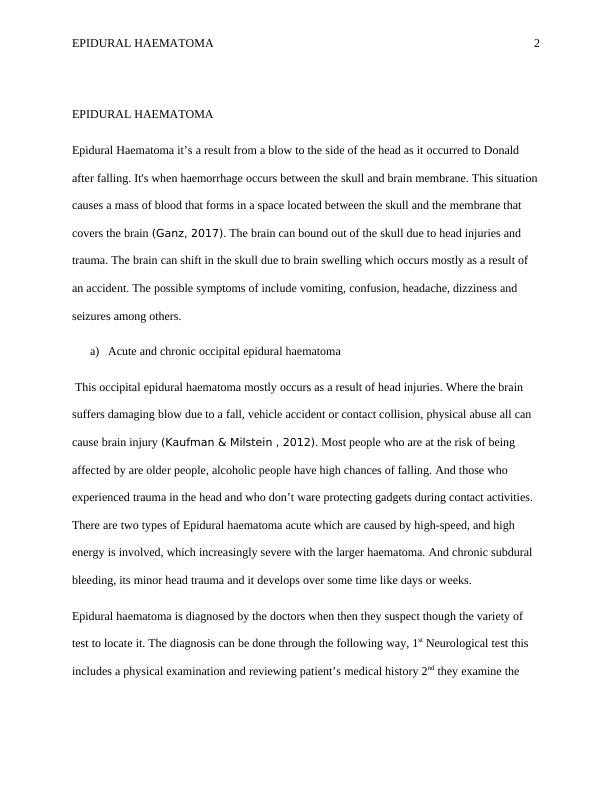Epidural Hematoma Case Study 2022
Added on 2022-09-28
7 Pages1539 Words24 Views
Running head: EPIDURAL HAEMATOMA 1
Name
Institutional affiliation
Name
Institutional affiliation

EPIDURAL HAEMATOMA 2
EPIDURAL HAEMATOMA
Epidural Haematoma it’s a result from a blow to the side of the head as it occurred to Donald
after falling. It's when haemorrhage occurs between the skull and brain membrane. This situation
causes a mass of blood that forms in a space located between the skull and the membrane that
covers the brain (Ganz, 2017). The brain can bound out of the skull due to head injuries and
trauma. The brain can shift in the skull due to brain swelling which occurs mostly as a result of
an accident. The possible symptoms of include vomiting, confusion, headache, dizziness and
seizures among others.
a) Acute and chronic occipital epidural haematoma
This occipital epidural haematoma mostly occurs as a result of head injuries. Where the brain
suffers damaging blow due to a fall, vehicle accident or contact collision, physical abuse all can
cause brain injury (Kaufman & Milstein , 2012). Most people who are at the risk of being
affected by are older people, alcoholic people have high chances of falling. And those who
experienced trauma in the head and who don’t ware protecting gadgets during contact activities.
There are two types of Epidural haematoma acute which are caused by high-speed, and high
energy is involved, which increasingly severe with the larger haematoma. And chronic subdural
bleeding, its minor head trauma and it develops over some time like days or weeks.
Epidural haematoma is diagnosed by the doctors when then they suspect though the variety of
test to locate it. The diagnosis can be done through the following way, 1st Neurological test this
includes a physical examination and reviewing patient’s medical history 2nd they examine the
EPIDURAL HAEMATOMA
Epidural Haematoma it’s a result from a blow to the side of the head as it occurred to Donald
after falling. It's when haemorrhage occurs between the skull and brain membrane. This situation
causes a mass of blood that forms in a space located between the skull and the membrane that
covers the brain (Ganz, 2017). The brain can bound out of the skull due to head injuries and
trauma. The brain can shift in the skull due to brain swelling which occurs mostly as a result of
an accident. The possible symptoms of include vomiting, confusion, headache, dizziness and
seizures among others.
a) Acute and chronic occipital epidural haematoma
This occipital epidural haematoma mostly occurs as a result of head injuries. Where the brain
suffers damaging blow due to a fall, vehicle accident or contact collision, physical abuse all can
cause brain injury (Kaufman & Milstein , 2012). Most people who are at the risk of being
affected by are older people, alcoholic people have high chances of falling. And those who
experienced trauma in the head and who don’t ware protecting gadgets during contact activities.
There are two types of Epidural haematoma acute which are caused by high-speed, and high
energy is involved, which increasingly severe with the larger haematoma. And chronic subdural
bleeding, its minor head trauma and it develops over some time like days or weeks.
Epidural haematoma is diagnosed by the doctors when then they suspect though the variety of
test to locate it. The diagnosis can be done through the following way, 1st Neurological test this
includes a physical examination and reviewing patient’s medical history 2nd they examine the

EPIDURAL HAEMATOMA 3
Skull and soft tissues in the brain through magnetic resonance imaging and computed
tomography scans. 3rd the doctors assess the brain's electrical activities through an
electroencephalogram (Kobeissy, 2015). Treatment depends on the acuteness and symptoms
of the condition.
b) How to manage acute and chronic occipital epidural haematoma
There are various ways used to manage post-traumatic epidural haematoma, which includes
conservative and surgical. Surgery is the most recommended way of epidural haematoma
treatment, where the doctors remove it and usually involves a craniotomy. Surgery is done by
surgeons to reduce the pressure on the brain, the doctors open up the skull and remove the
haematoma. Another of managing haematoma called Aspiration, where haematoma is sucked
through a hole made on the skull (Nanda, 2018). This process is done when there is no
pressure exerted on the brain. It's effective for very small haematoma.
Also, medication is another way of epidural haematoma treatment, doctors prescribe medication
to reduce inflammation and intracranial pressure. Hyperosmotic agents these drugs help in
reducing the swelling in the swelling in the brain. These drugs include glycerol, hypertonic saline
and mannitol (Martin & Kaplan, 2016). The doctors can prescribe anti-seizure medications
after haematoma has been removed to prevent seizures, any possible complication of head injury.
These medications can be taken months or even years.
Physical, occupation or any other rehabilitative therapy is another way used in the treatment of
epidural haematoma (Braddom, 2010). It helps to manage symptoms and disability caused by
Skull and soft tissues in the brain through magnetic resonance imaging and computed
tomography scans. 3rd the doctors assess the brain's electrical activities through an
electroencephalogram (Kobeissy, 2015). Treatment depends on the acuteness and symptoms
of the condition.
b) How to manage acute and chronic occipital epidural haematoma
There are various ways used to manage post-traumatic epidural haematoma, which includes
conservative and surgical. Surgery is the most recommended way of epidural haematoma
treatment, where the doctors remove it and usually involves a craniotomy. Surgery is done by
surgeons to reduce the pressure on the brain, the doctors open up the skull and remove the
haematoma. Another of managing haematoma called Aspiration, where haematoma is sucked
through a hole made on the skull (Nanda, 2018). This process is done when there is no
pressure exerted on the brain. It's effective for very small haematoma.
Also, medication is another way of epidural haematoma treatment, doctors prescribe medication
to reduce inflammation and intracranial pressure. Hyperosmotic agents these drugs help in
reducing the swelling in the swelling in the brain. These drugs include glycerol, hypertonic saline
and mannitol (Martin & Kaplan, 2016). The doctors can prescribe anti-seizure medications
after haematoma has been removed to prevent seizures, any possible complication of head injury.
These medications can be taken months or even years.
Physical, occupation or any other rehabilitative therapy is another way used in the treatment of
epidural haematoma (Braddom, 2010). It helps to manage symptoms and disability caused by

End of preview
Want to access all the pages? Upload your documents or become a member.
Related Documents
The Epidural Haematoma - PDFlg...
|7
|1387
|93
RESEARCH DISSERTATION TITLE:1 CHAPTER 1: INTRODUCTION1 1.1 Background and Research Aim 2 1.5 Research Objective 3 1.6 Research Question 3: LITERATURE REVIEW4 CHAPTER 3: RESEARCH METHODOLOGY8 3.4 Datalg...
|24
|6184
|263
Renal and Genitourinary Systemlg...
|4
|846
|395
Blood Pressure Management of Patients with SAH: A Literature Reviewlg...
|14
|3274
|443
